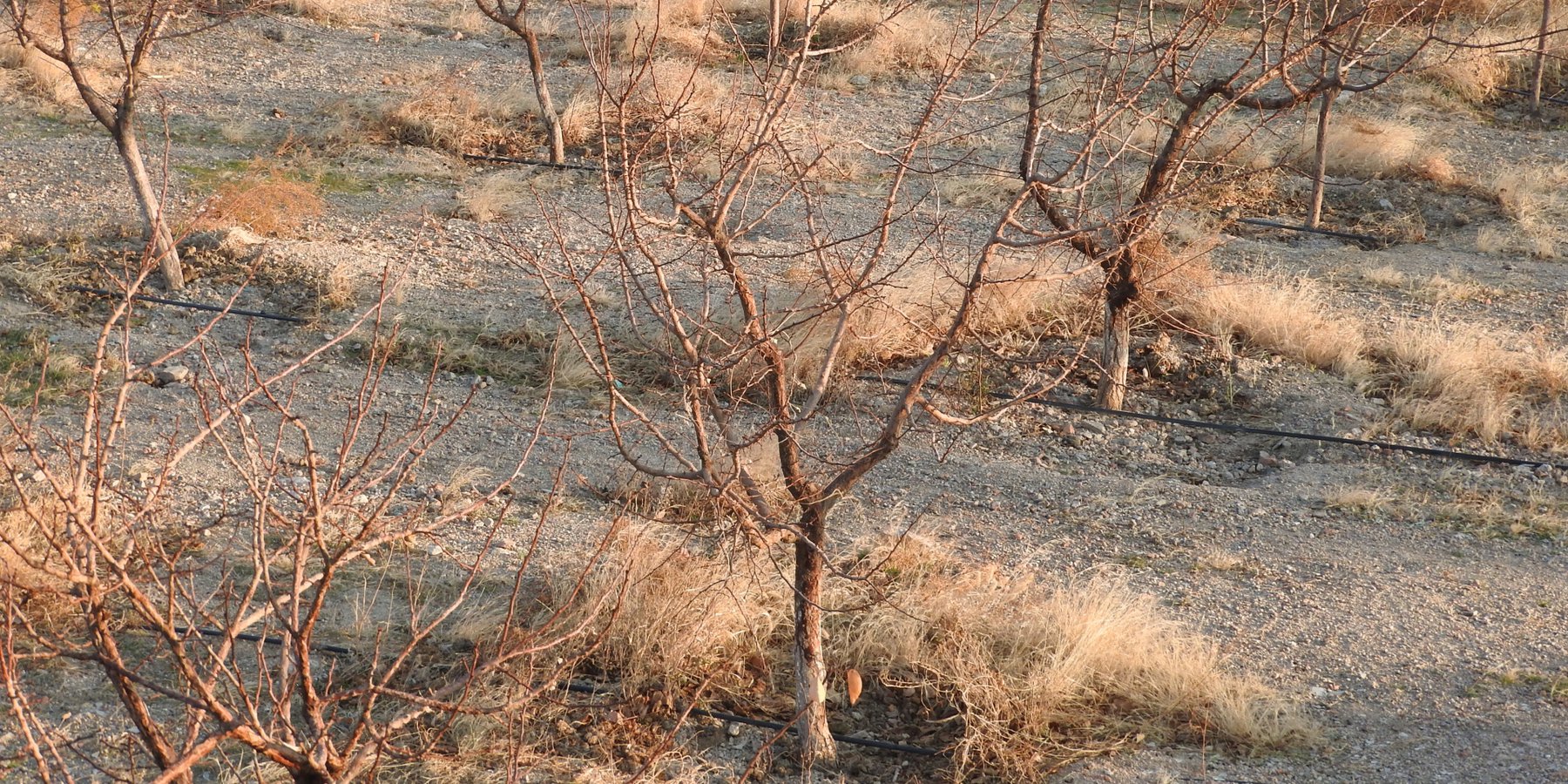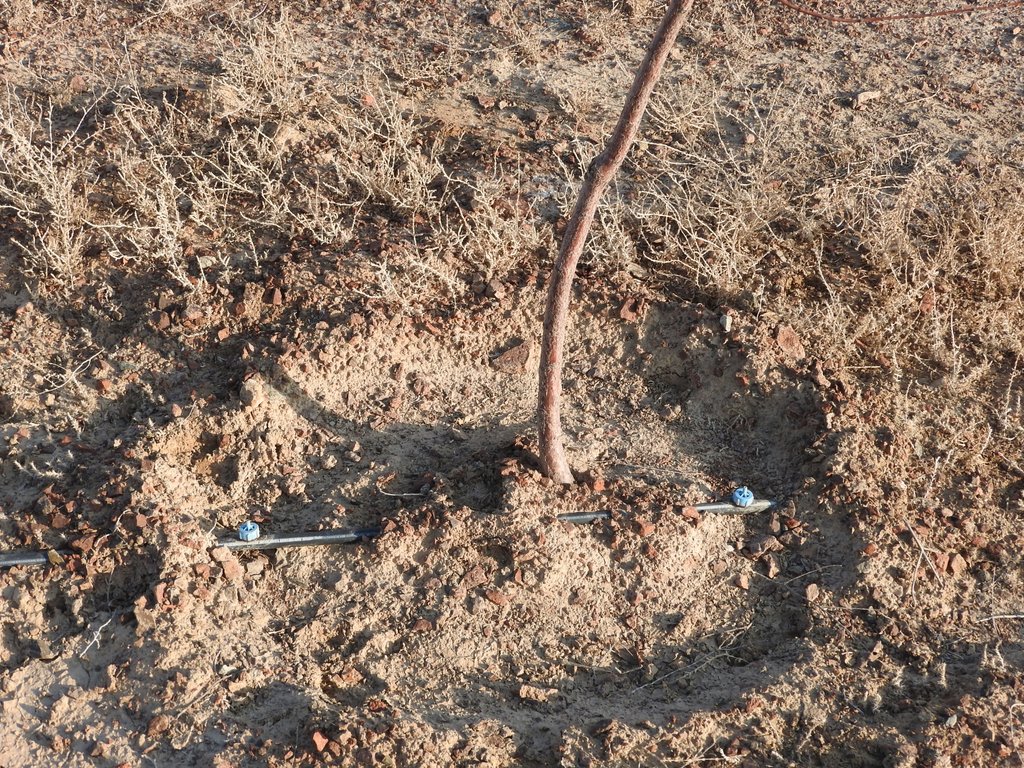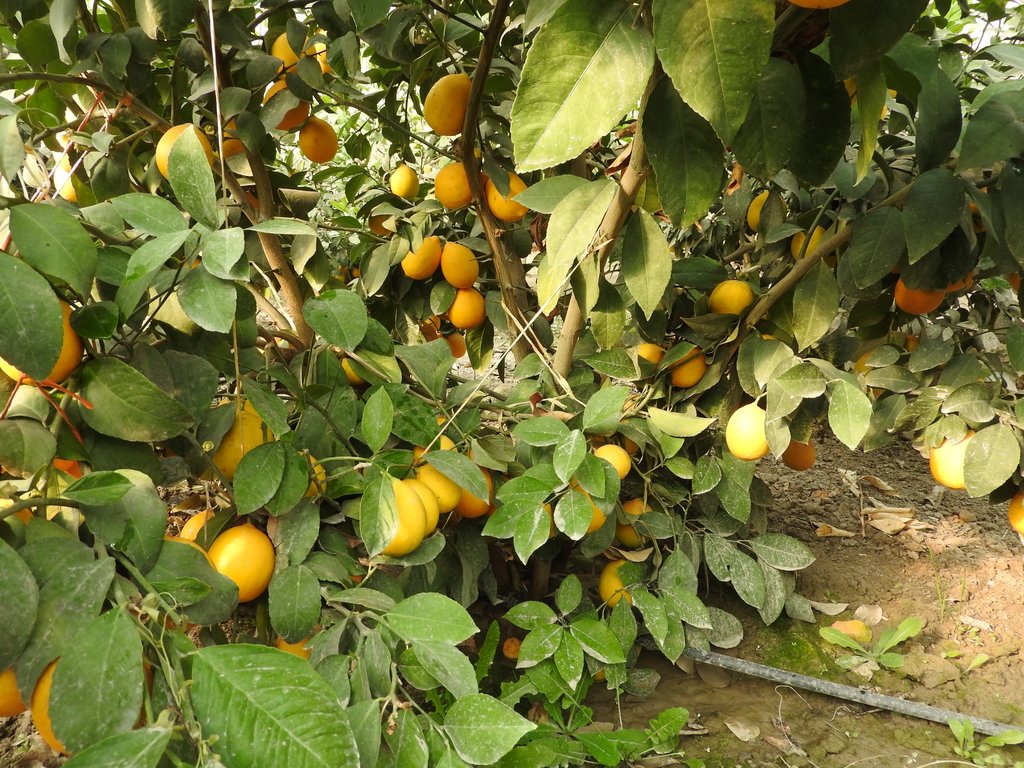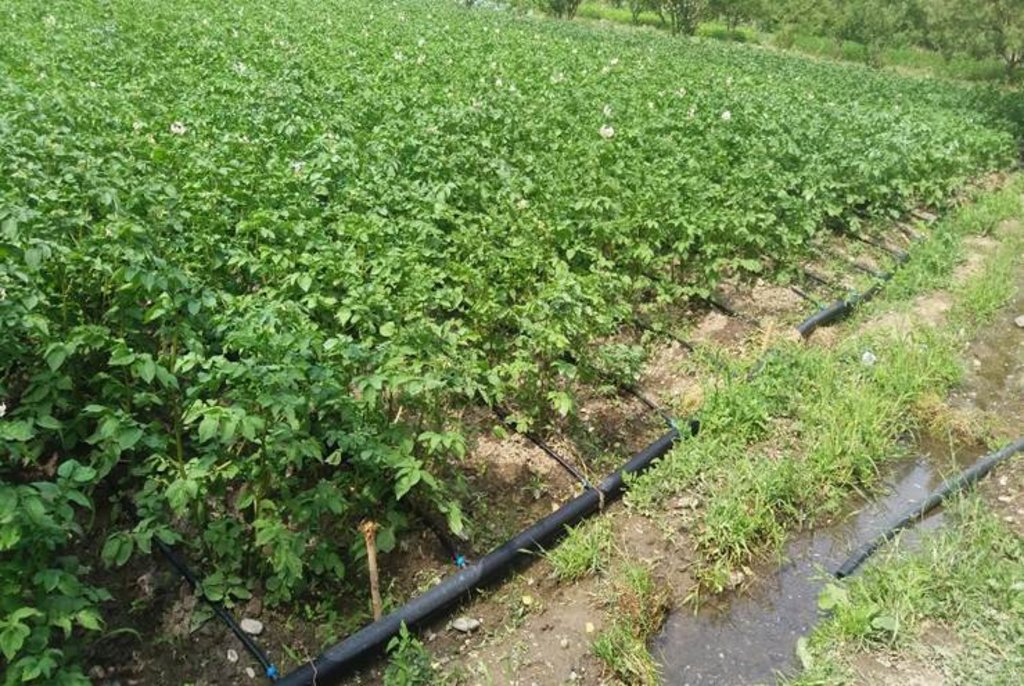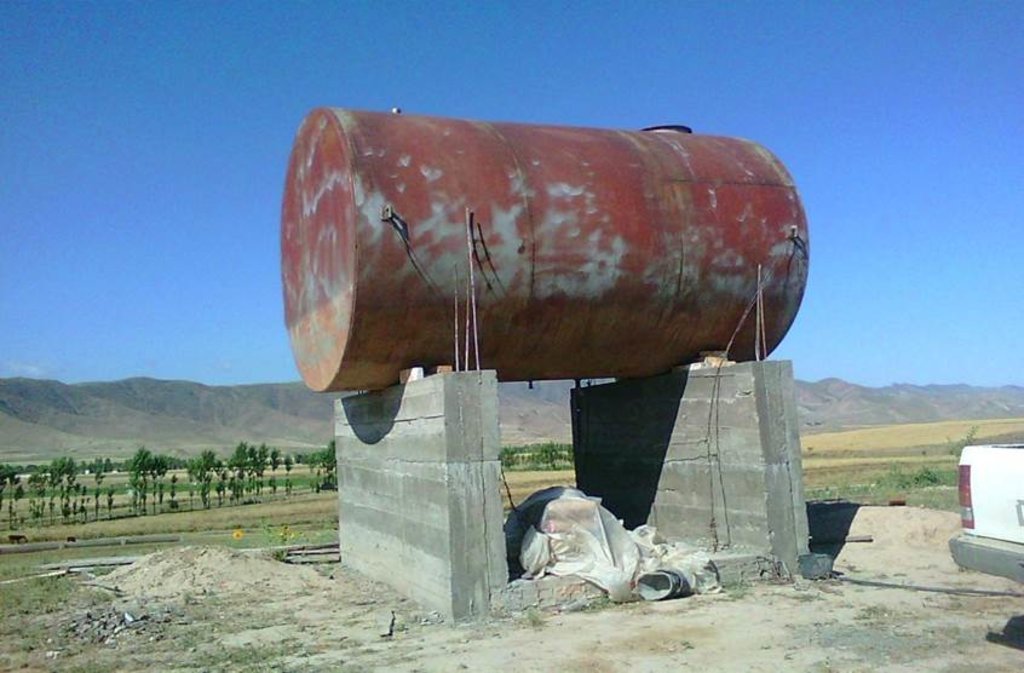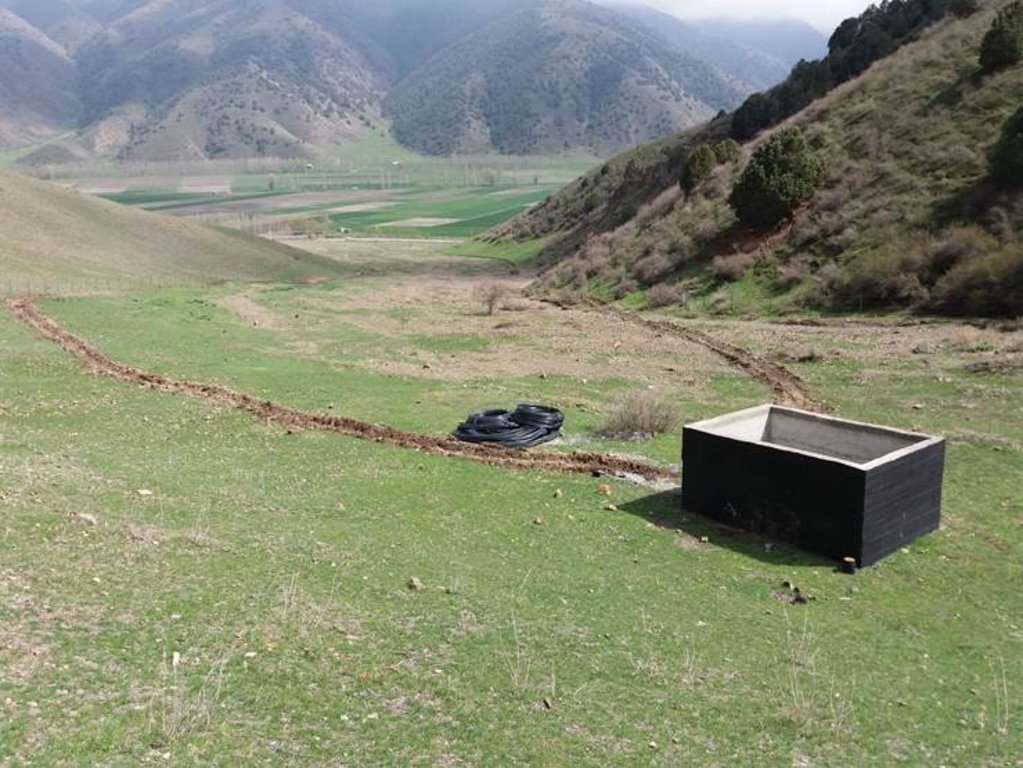Applying drip irrigation for efficient irrigation water use in varying contexts [塔吉克斯坦]
- 创建:
- 更新:
- 编制者: Stefan Michel
- 编辑者: –
- 审查者: Umed Vahobov
Применение технологии капельного орошения для эффективного использования ирригационной воды
technologies_4307 - 塔吉克斯坦
查看章节
全部展开 全部收起1. 一般信息
1.2 参与该技术评估和文件编制的资源人员和机构的联系方式
关键资源人
SLM专业人员:
Muhidinov Nodir
Deutsche Gesellschaft für Internationale Zusammenarbeit (GIZ)
塔吉克斯坦
SLM专业人员:
Negmatov Negmatjon
Deutsche Gesellschaft für Internationale Zusammenarbeit (GIZ)
塔吉克斯坦
有助于对技术进行记录/评估的项目名称(如相关)
Strengthening of Livelihoods through Climate Change Adaptation in Kyrgyzstan and Tajikistan有助于对技术进行记录/评估的机构名称(如相关)
Deutsche Gesellschaft für Internationale Zusammenarbeit - Tajikistan (GIZ Tajikistan) - 塔吉克斯坦1.3 关于使用通过WOCAT记录的数据的条件
编制者和关键资源人员接受有关使用通过WOCAT记录数据的条件。:
是
1.4 所述技术的可持续性声明
这里所描述的技术在土地退化方面是否存在问题,导致无法被认为是一种可持续的土地管理技术?:
否
1.5 参考关于SLM方法(使用WOCAT记录的SLM方法)的调查问卷
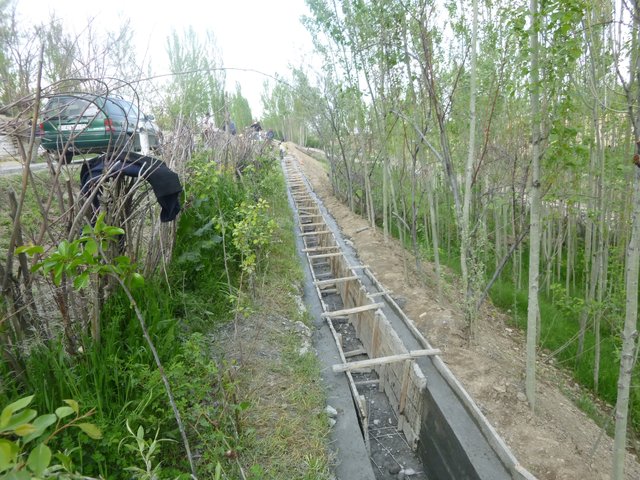
Increased efficiency of irrigation water use to address … [塔吉克斯坦]
Climate change impact contributes to irrigation water shortage. The approach of improving irrigation water delivery, distribution and use prevents irrigation water losses and increases the productivity per amount of irrigation water available.
- 编制者: Stefan Michel
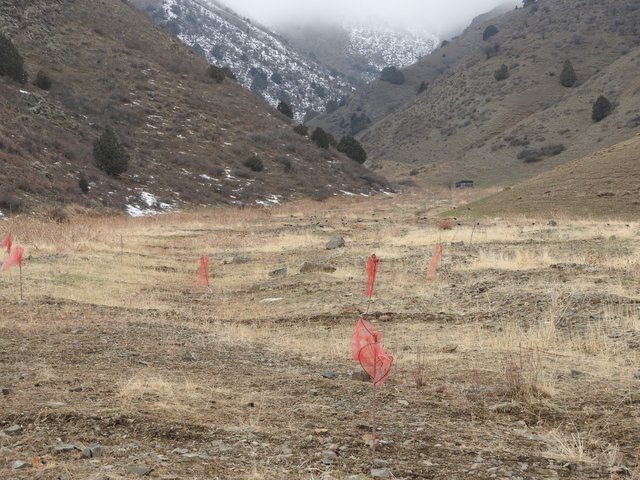
Disaster risk reduction and sustainable land-use by integrated … [塔吉克斯坦]
A site affected by a debris flow was rehabilitated by joint communal work and integrated preventive measures addressing the upper catchment as well as the valley and the debris conus were implemented in collaboration of community, individual farmers, Committee of Emergency Situations and forestry enterprise.
- 编制者: Stefan Michel
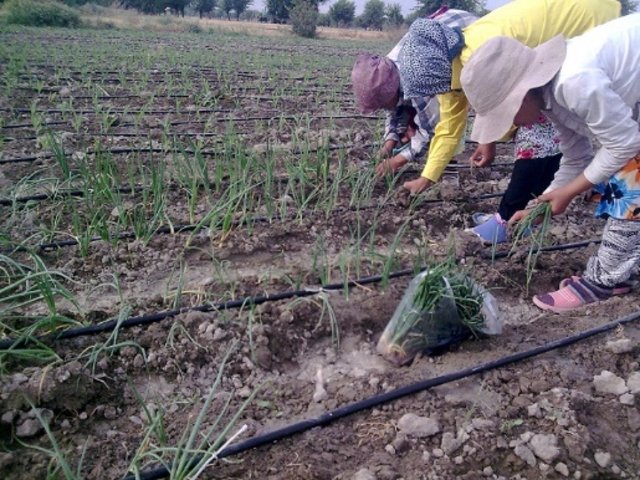
Integrated farming on irrigated lands for adaptation to … [塔吉克斯坦]
Irrigated agriculture faces challenges from climate change impact and growing competition for irrigation water. The approach to get "more crop per drop" reduces the adverse effect of these impacts and improves the income of farmers.
- 编制者: Stefan Michel
2. SLM技术的说明
2.1 技术简介
技术定义:
Drip irrigation substantially saves water compared to conventional furrow irrigation. Here the technology is applied for different perennial and annual crops and with use of different sources of water.
2.2 技术的详细说明
说明:
In the arid areas of Sughd region cultivation of most crops is possible with irrigation only. In many cases conventional furrow irrigation is limited or impossible due to insufficient availability of irrigation water. Furthermore, conventional furrow irrigation is often connected with problems which make irrigated farming unsustainable – high water demand causes shortages for downstream water users and ecosystems, irrigation water can flush out nutrients from soil or cause erosion, high amounts of irrigation water and insufficient drainage can lead to waterlogging and where soil and/or irrigation water contain high amounts of salt to salinization. From an economic perspective, the high amounts of irrigation water required for conventional irrigation can be costly, especially where pumping from sources to fields at higher elevation is required. Climate change impacts like increasing aridity, changing seasonality of rainfall, reduced storage of precipitation as snow and glacier ice and resulting irrigation water shortages during critical seasons require adaptation in irrigated agriculture.
The broader application of drip irrigation is one way to address economic and environmental issues of irrigated farming, while specifically addressing climate change impact. The major effect of drip irrigation is the increased irrigation water use efficiency – “More crop per drop”. This avoids or reduces the above explained impacts of conventional furrow irrigation: water demand is massively reduced allowing irrigating fields and orchards in areas where water availability would not allow for conventional irrigated agriculture; loss of soil nutrients, irrigation induced erosion and waterlogging are avoided, salinization is much less likely and occurs only in small extent in cases where highly mineralized irrigation water is applied (not an issue in the described project region). The reduced need for irrigation water avoids conflict with downstream water users and the needs of ecosystems. Under climate change impact farmers applying drip irrigation have a higher security that sufficient irrigation water is available and the drip irrigation technology allows for an adapted provision of water to the crops in accordance to their physiological demand. Drip irrigation systems can be used to apply the accurate dosages of fertilizer directly to the plants. This increases the effectiveness of fertilizing and the efficiency in terms of costs as much less fertilizer is not taken by the crops.
Drip irrigation is applied for various crops:
•perennial crops: orchards of apple, apricot, pear and other fruit trees, vineyards, lemons in greenhouses;
•corn, onions, potatoes; and
•honey melon and water melon.
The high initial investment influences on the economic profitability of the technology. The project demonstrated that drip irrigation can be used not only for orchards, where it has an advantage over field crops, because there is no need re-install pipes every season. But it can be used for crops such as melons, onion, sunflower and corn. In the case of honey melon and water melon drip irrigation is particularly efficient due to the large area covered by every single plant. Thus the distances between pipes and between drippers can be large to supply each plant, but the plants with their long tendrils and large leaves effectively use the space in between. In trials of onion cultivation the generally high investment needs, required density of tubes and drippers and the comparably low market price made the technology in not economically competitive under current circumstances.
Drip irrigation can be applied with various sources of irrigation water. Compared to conventional furrow irrigation even low amounts of irrigation water or water from comparably costly sources can be effectively used. In the frame of the documented trials the following sources of irrigation water have been used for supplying drip irrigation systems in addition to water from irrigation canals:
•spring water collection with concrete reservoir;
•water from draw well, pumped to small water tower above the well and from their running by gravitation to concrete reservoir, from where it is supplying the drip irrigation system;
•rain water collection from house roofs with concrete reservoir;
•irrigation water withdrawn by large pumps from Syrdarya river and supplied via pipelines to newly irrigated areas;
•irrigation water from household water supply system, stored in concrete reservoir during day times of low demand.
The drip irrigation systems are equipped with manual (use of local irrigation water stored in concrete reservoirs or barrels) or automatic (direct use of irrigation water from pipelines) pressure regulation valves. At the outlets of reservoirs or at the pressure regulations device fertilizer can be added and provided to the plants in exact dosage.
2.3 技术照片
2.5 已应用该技术的、本评估所涵盖的国家/地区/地点
国家:
塔吉克斯坦
区域/州/省:
Sughd region
具体说明该技术的分布:
- 适用于特定场所/集中在较小区域
技术现场是否位于永久保护区?:
否
Map
×2.6 实施日期
注明实施年份:
2017
如果不知道确切的年份,请说明大概的日期:
- 不到10年前(最近)
2.7 技术介绍
详细说明该技术是如何引入的:
- 通过项目/外部干预
3. SLM技术的分类
3.1 该技术的主要目的
- 改良生产
- 适应气候变化/极端天气及其影响
- 创造有益的经济影响
- 创造有益的社会影响
3.2 应用该技术的当前土地利用类型
同一土地单元内混合使用的土地::
否

农田
- 一年一作
- 多年一作(非木材)
- 乔木与灌木的种植
年作 - 具体指明作物:
- 谷物类 - 玉米
- 油料作物 - 向日葵、菜籽、其他
- 蔬菜 - 香瓜、南瓜、南瓜或葫芦
- 蔬菜 - 根茎类蔬菜(胡萝卜、洋葱、甜菜等)
乔木和灌木种植 - 指定作物:
- 柑橘属
- 水果、其他
- 葡萄
每年的生长季节数:
- 1
采用间作制度了吗?:
否
采用轮作制度了吗?:
是
3.3 由于技术的实施,土地使用是否发生了变化?
由于技术的实施,土地使用是否发生了变化?:
- 是(请在技术实施前填写以下有关土地利用的问题)
同一土地单元内混合使用的土地::
否

牧场
- unregulated
动物类型:
- 山羊
- 绵羊

不毛之地
具体说明:
Desert/deserted rangeland
3.4 供水
该技术所应用土地的供水:
- 充分灌溉
3.5 该技术所属的SLM组
- 集水
- 灌溉管理(包括供水、排水)
3.6 包含该技术的可持续土地管理措施

结构措施
- S7:集水/供水/灌溉设备
3.7 该技术强调的主要土地退化类型

土壤水蚀
- Wt:表土流失/地表侵蚀
- Wg:冲沟侵蚀/沟蚀

化学性土壤退化
- Cn:肥力下降和有机质含量下降(非侵蚀所致)
- Cs:盐化/碱化
3.8 防止、减少或恢复土地退化
具体数量名该技术与土地退化有关的目标:
- 减少土地退化
- 适应土地退化
4. 技术规范、实施活动、投入和成本
4.2 有关投入和成本计算的一般信息
具体说明成本和投入是如何计算的:
- 每个技术区域
注明尺寸和面积单位:
ha
其它/国家货币(具体说明):
TJS
如相关,注明美元与当地货币的汇率(例如1美元=79.9巴西雷亚尔):1美元=:
8.0
4.3 技术建立活动
| 活动 | 时间(季度) | |
|---|---|---|
| 1. | Construction of water supply and storage structures | before irrigation season |
| 2. | Installation of drip irrigation system | early in spring |
| 3. | Draining of water storages and drip irrigation system | before cold season sets in |
4.4 技术建立所需要的费用和投入
| 对投入进行具体说明 | 单位 | 数量 | 单位成本 | 每项投入的总成本 | 土地使用者承担的成本% | |
|---|---|---|---|---|---|---|
| 劳动力 | Construction of water withdrawal systems | |||||
| 劳动力 | Construction of rainwater harvest systems | |||||
| 劳动力 | Construction of water storage | |||||
| 劳动力 | Installation of drip irrigation systems | ha | 5.0 | 2800.0 | 14000.0 | |
| 施工材料 | Water withdrawal systems | |||||
| 施工材料 | Rainwater harvest systems | |||||
| 施工材料 | Water storage systems | |||||
| 施工材料 | Drip irrigation system orchard | ha | 5.0 | 7000.0 | 35000.0 | |
| 施工材料 | Drip irrigation system onion field | ha | 1.0 | 20000.0 | 20000.0 | |
| 技术建立所需总成本 | 69000.0 | |||||
| 技术建立总成本,美元 | 8625.0 | |||||
如果土地使用者负担的费用少于100%,请注明由谁负担其余费用:
All investment costs of trials had been covered by the project
注释:
Costs vary between the specific situations, depending on type of crop, of water supply and of water storage as well as area sizes. Inquiries about detailed costs can be send to the project.
4.5 维护/经常性活动
| 活动 | 时间/频率 | |
|---|---|---|
| 1. | Refilling of water storage | Depending on specific situation |
| 2. | Regulation of water supply in drip irrigation system | Permanently during irrigation season |
| 3. | Control and cleaning of drippers as necessary | At least weekly |
4.6 维护/经常性活动所需要的费用和投入(每年)
注释:
Costs vary between the specific situations, depending on type of crop, of water supply and of water storage as well as area sizes. Inquiries about detailed costs can be send to the project.
4.7 影响成本的最重要因素
描述影响成本的最决定性因素:
Water supply and storage systems, densities of drip irrigation pipes and drippers.
5. 自然和人文环境
5.1 气候
年降雨量
- < 250毫米
- 251-500毫米
- 501-750毫米
- 751-1,000毫米
- 1,001-1,500毫米
- 1,501-2,000毫米
- 2,001-3,000毫米
- 3,001-4,000毫米
- > 4,000毫米
指定年平均降雨量(若已知),单位为mm:
221.00
有关降雨的规范/注释:
Rainfall varies between sites
注明所考虑的参考气象站名称:
Khujand
农业气候带
- 半干旱
- 干旱
5.2 地形
平均坡度:
- 水平(0-2%)
- 缓降(3-5%)
- 平缓(6-10%)
- 滚坡(11-15%)
- 崎岖(16-30%)
- 陡峭(31-60%)
- 非常陡峭(>60%)
地形:
- 高原/平原
- 山脊
- 山坡
- 山地斜坡
- 麓坡
- 谷底
垂直分布带:
- 0-100 m a.s.l.
- 101-500 m a.s.l.
- 501-1,000 m a.s.l.
- 1,001-1,500 m a.s.l.
- 1,501-2,000 m a.s.l.
- 2,001-2,500 m a.s.l.
- 2,501-3,000 m a.s.l.
- 3,001-4,000 m a.s.l.
- > 4,000 m a.s.l.
关于地形的注释和进一步规范:
Various altitudes.
5.3 土壤
如有可能,附上完整的土壤描述或具体说明可用的信息,例如土壤类型、土壤酸碱度、阳离子交换能力、氮、盐度等。:
Various soil situations
5.4 水资源可用性和质量
地表水的可用性:
匮乏/没有
水的盐度有问题吗?:
否
该区域正在发生洪水吗?:
否
关于水质和水量的注释和进一步规范:
Grond water table varying between <5 m and >50 m.
5.5 生物多样性
物种多样性:
- 低
栖息地多样性:
- 低
5.6 应用该技术的土地使用者的特征
定栖或游牧:
- 定栖的
生产系统的市场定位:
- 混合(生计/商业)
非农收入:
- 低于全部收入的10%
- 收入的10-50%
相对财富水平:
- 平均水平
个人或集体:
- 个人/家庭
- 团体/社区
机械化水平:
- 手工作业
- 机械化/电动
性别:
- 女人
- 男人
土地使用者的年龄:
- 儿童
- 青年人
- 中年人
- 老年人
5.7 应用该技术的土地使用者使用的平均土地面积
- < 0.5 公顷
- 0.5-1 公顷
- 1-2 公顷
- 2-5公顷
- 5-15公顷
- 15-50公顷
- 50-100公顷
- 100-500公顷
- 500-1,000公顷
- 1,000-10,000公顷
- > 10,000公顷
这被认为是小规模、中规模还是大规模的(参照当地实际情况)?:
- 小规模的
- 中等规模的
5.8 土地所有权、土地使用权和水使用权
土地所有权:
- 州
土地使用权:
- 个人
- Kindergarten, gov't agency
用水权:
- 社区(有组织)
- 个人
- Gov't organizations
土地使用权是否基于传统的法律制度?:
否
5.9 进入服务和基础设施的通道
健康:
- 贫瘠
- 适度的
- 好
教育:
- 贫瘠
- 适度的
- 好
技术援助:
- 贫瘠
- 适度的
- 好
就业(例如非农):
- 贫瘠
- 适度的
- 好
市场:
- 贫瘠
- 适度的
- 好
能源:
- 贫瘠
- 适度的
- 好
道路和交通:
- 贫瘠
- 适度的
- 好
饮用水和卫生设施:
- 贫瘠
- 适度的
- 好
金融服务:
- 贫瘠
- 适度的
- 好
6. 影响和结论性说明
6.1 该技术的现场影响
社会经济效应
生产
作物生产
注释/具体说明:
Varying, depending on crop and specific situation.
生产故障风险
注释/具体说明:
Varying, depending on crop and specific situation.
生产区域
注释/具体说明:
Areas of several hundred hectares additionally cultivated (ongoing)
水资源可用性和质量
灌溉用水的可用性
注释/具体说明:
Absolute quantity of additionally available irrigation water is not high, but due to efficient use actually possible addtional irrigation is significant.
灌溉用水需求
注释/具体说明:
Actual consumption of irrigation water has not declined, but unsatisfied demand declined.
收入和成本
农业投入费用
注释/具体说明:
Expensive on-farm infrastructure required
工作量
注释/具体说明:
Workload for installation and maintenance is higher than for conventional furrow irrigation.
生态影响
水循环/径流
水量
注释/具体说明:
Increase in area and productivity of irrigated lands without substantial increase of water withdrawal.
水的回收/收集
注释/具体说明:
Use of water from previously not effectively used sources - rainwater from roofs, small springs, small wells.
减少气候和灾害风险
滑坡/泥石流
注释/具体说明:
Use of drip irrigation for establishment of tree cover at debris flow site.
干旱影响
注释/具体说明:
Improved drought resistance by better availability, regulation and efficient use of irrigation water
6.2 该技术的场外影响已经显现
水资源可用性
注释/具体说明:
Avoided reduction of water availability due to use of water efficient irrigation technology in newly irrigated areas.
对邻近农田的破坏
注释/具体说明:
Use of drip irrigation for establishment of tree cover at debris flow site.
对公共/私人基础设施的破坏
注释/具体说明:
Use of drip irrigation for establishment of tree cover at debris flow site.
6.3 技术对渐变气候以及与气候相关的极端情况/灾害的暴露和敏感性(土地使用者认为的极端情况/灾害)
渐变气候
渐变气候
| 季节 | 增加或减少 | 该技术是如何应对的? | |
|---|---|---|---|
| 季节性温度 | 旱季 | 增加 | 好 |
| 年降雨量 | 减少 | 好 | |
| 季雨量 | 减少 | 好 |
6.4 成本效益分析
技术收益与技术建立成本相比如何(从土地使用者的角度看)?
短期回报:
消极
长期回报:
积极
技术收益与技术维护成本/经常性成本相比如何(从土地使用者的角度看)?
短期回报:
积极
长期回报:
积极
注释:
High establishment costs.
6.5 技术采用
- 1-10%
如若可行,进行量化(住户数量和/或覆盖面积):
Beyond the trials supported by the project the technology is now applied as standard irrigation technology in the newly irrigated areas of Sayhun.
在所有采用这项技术的人当中,有多少人是自发的,即未获得任何物质奖励/付款?:
- 51-90%
注释:
Under consideration of the newly irrigated areas of Sayhun.
6.6 适应
最近是否对该技术进行了修改以适应不断变化的条件?:
否
6.7 该技术的优点/长处/机会
| 土地使用者眼中的长处/优势/机会 |
|---|
| Irrigation possible in areas with irrigation water supply insufficient for conventional irrigation technologies. |
| Low amount of irrigation water needed for effective irrigation. |
| Potential of expansion of irrigated land use in previously non-irrigable areas. |
| 编制者或其他关键资源人员认为的长处/优势/机会 |
|---|
| Same as land-user's view. |
6.8 技术的弱点/缺点/风险及其克服方法
| 土地使用者认为的弱点/缺点/风险 | 如何克服它们? |
|---|---|
| Expensive initial investment |
External financial support; Choice of most efficient options, use of cheap versions. |
| Costs of replacement of damaged parts of the system and access to replacement parts |
External financial support; provision of replacement parts |
| 编制者或其他关键资源人员认为的弱点/缺点/风险 | 如何克服它们? |
|---|---|
| Expensive initial investment |
Decrease of costs as market of equipment becomes larger; Provision of access to suitable financing schemes; Application of the technology for crops with high cross margin per area unit/per investment in irrigation. |
| Costs of replacement of damaged parts of the system and access to replacement parts |
Capacity development on proper maintenance, in particular draining before the cold season; Assistance in purchase of durable parts via extension services/procurement cooperatives. |
7. 参考和链接
7.1 信息的方法/来源
- 实地考察、实地调查
- 与土地使用者的访谈
- 与SLM专业人员/专家的访谈
(现场)数据是什么时候汇编的?:
27/11/2018
注释:
27-29/11/2018
链接和模块
全部展开 全部收起链接

Increased efficiency of irrigation water use to address … [塔吉克斯坦]
Climate change impact contributes to irrigation water shortage. The approach of improving irrigation water delivery, distribution and use prevents irrigation water losses and increases the productivity per amount of irrigation water available.
- 编制者: Stefan Michel

Disaster risk reduction and sustainable land-use by integrated … [塔吉克斯坦]
A site affected by a debris flow was rehabilitated by joint communal work and integrated preventive measures addressing the upper catchment as well as the valley and the debris conus were implemented in collaboration of community, individual farmers, Committee of Emergency Situations and forestry enterprise.
- 编制者: Stefan Michel

Integrated farming on irrigated lands for adaptation to … [塔吉克斯坦]
Irrigated agriculture faces challenges from climate change impact and growing competition for irrigation water. The approach to get "more crop per drop" reduces the adverse effect of these impacts and improves the income of farmers.
- 编制者: Stefan Michel
模块
无模块


